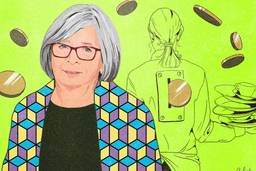Toward the end of F. Scott Fitzgerald’s “The Crack-Up,” an essay about his personal decline during the Great Depression, he wrote, “The natural state of the sentient adult is a qualified unhappiness.” Glancing at the headlines today, it’s hard not to agree.
Within the past six months, a spate of books on happiness has appeared in stores as if to remind us of our right to pursue it. Positive-psychology enthusiasts Daniel Gilbert and Jonathan Haidt arrived with Stumbling on Happiness and The Happiness Hypothesis, respectively. Former cell biologist-cum-Buddhist monk Matthieu Ricard, with Richard Gere’s seal of approval, wrote Happiness: A Guide to Developing Life’s Most Important Skill. And Darrin M. McMahon, an intellectual historian, produced the exhaustively researched and edifying Happiness: A History.
The idea of a right to happiness is a relatively new phenomenon. In ancient Greece, happiness materialized in life as in plays: via deus ex machina. In other traditions, happiness was reserved for the “godlike” few – a Stoic ascetic, say, or Catholic saint – and the average person sought it only in otherworldly realms like the Elysium fields. Our understanding of happiness shifted during the Enlightenment, McMahon says, when, theoretically at least, everyone could attain happiness on earth.
Happiness: A History is not a self-help book and does not teach the reader how to acquire contentment. It does, however, encourage the reader to consider happiness more critically – McMahon shows that much of happiness is relative. Take wealth, for example: how much a person wants depends entirely on how much their peer group possesses. McMahon also notes the pernicious effects of the happy faces in advertising. When you measure your own face against them, you might register a tinge of sadness. McMahon calls this the unhappiness of not being happy.
Ricard sees harm in advertising, too. Our consumer society tirelessly produces “countless bogus pleasures” that detract from a lasting contentment. He wants the reader to grasp the difference between true joy – a natural manifestation of well-being – and euphoric fleeting pleasures. Ricard offers meditation exercises to help the reader make these distinctions. The goal is developing a level of introspection that will dispel ignorance, encourage empathy and lead to true happiness.
Haidt also recommends meditation in The Happiness Hypothesis. It, like Prozac and cognitive therapy, helps to offset your “low biological set point,” or your genes, which may be part of the problem. But unhappy biology need not translate to an unhappy destiny. Haidt shows that conditions such as a long commute or voluntary activities like exercising influence your level of contentment as well. The crux of Haidt’s project is locating a balance between philosophical insight, the findings of neurology, and Eastern and Western modes of thought.
Finding a balance between the present and the future is Gilbert’s project in Stumbling on Happiness. The vision we have of what will make us happy in the future is a mere reflection of our present. But our imagination is as unreliable as our memory; we can’t correctly foresee what will make us happy in the future. Moreover, in the face of adversity, our “psychological immune system” kicks in and we overcompensate for hardship by way of explanation. These explanations transform experience.
Gilbert might explain this particular outpouring of books as the kicking in of our collective “psychological immune system” in an increasingly disillusioned post-9/11 society. McMahon similarly observes that, “the very prevalence of these titles is a sign that all is not well.”
Indeed, these current books evoke the publishing industry’s propensity for promoting books on depression during the ’90s – when the giddy dot-com boom promised wealth for all. Prozac Nation and Listening to Prozac were published in concert with the pharmaceutical industry’s aggressive campaign to sell selective serotonin reuptake inhibitors. So, when we were happy, we read about being sad.
Mired in the present political situation, these new books seem to want to preclude an epidemic of depression, even though millions are already taking SSRIs. More than that, though, goading happiness is a way to avert a crisis of consumer confidence. Recall that Bush’s post 9/11 advice for Americans looking to serve their country was to go shopping. He couldn’t tell us to cheer up, so he told us to go buy stuff.
These books never offer such advice. In fact, most of these writers eschew the concept that material possessions offer solace – except for Gilbert, who is strangely in thrall to the Mercedes-Benz SL600. Look inward, says the Buddhist. Work capably regardless of your station because you never know what will make you happy, say the positive psychologists. Even the historian’s study retains a whiff of the industry agenda: Contemplate ideas of happiness from days of yore, McMahon says, and decide what works for you. Buy these books, says the industry, and life can be good.
On one other point they all seem to agree: If you’re unhappy it’s your problem. The onus to be happy is squarely on the individual, not on changing the status quo.
In the ’30s, Fitzgerald could see the connection that these writers do not: “My recent experience parallels the wave of despair that swept the nation when the boom was over.” Taken together these books somehow miss the point that so much of our personal unhappiness stems from the darkening political situation in this country. To paraphrase Adorno, they fail to see that being happy after Guantánamo is barbaric.





